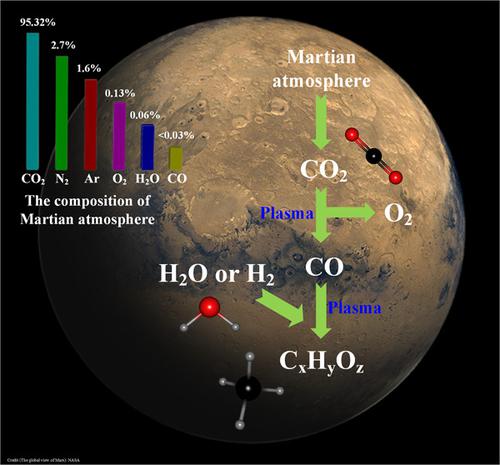当前位置:
X-MOL 学术
›
Plasma Processes Polym.
›
论文详情
Our official English website, www.x-mol.net, welcomes your
feedback! (Note: you will need to create a separate account there.)
Investigation on the products distribution, reaction pathway, and discharge mechanism of low-pressure CO2 discharge by employing a 1D simulation model
Plasma Processes and Polymers ( IF 2.9 ) Pub Date : 2021-04-01 , DOI: 10.1002/ppap.202000228 Cong Wang 1 , Qiang Fu 1 , Zhengshi Chang 1 , Guanjun Zhang 1
Plasma Processes and Polymers ( IF 2.9 ) Pub Date : 2021-04-01 , DOI: 10.1002/ppap.202000228 Cong Wang 1 , Qiang Fu 1 , Zhengshi Chang 1 , Guanjun Zhang 1
Affiliation

|
Mars has a special carbon dioxide environment. The surface and atmosphere of Mars contain a large amount of solid and gaseous carbon dioxide, which makes the in-situ resource utilization of Martian carbon dioxide attract widespread attention. The conversion of carbon dioxide into fuel or high value-added products through electrical discharge has become a research focus, in which numerical simulation is one of the important means to explain the experimental phenomenon and the mechanism. Therefore, a one-dimensional fluid model was established in this paper to simulate the discharge and conversion of carbon dioxide under simulated Martian atmospheric pressure. The discharge mode, particle distribution, and discharge mechanism were studied by considering CO2 vibrational states and vibration relaxation reaction in the model. The results show that the discharge mode is glow discharge with an obvious cathode fall region, negative glow space, and positive column. The density of the four discharge products, C, O2, CO, and O, shows a step-up trend, showing a significant cumulative effect, and the peak values appear near both electrodes. The density of vibrational states of CO2 molecule, which is highest in the neutral products, increases during the discharge stage and decreases after the discharge is extinguished. The temporal and spatial distribution of reaction rates shows that vibrational excitation, electronic excitation, and vibrational relaxation reactions dominate the loss and formation of CO2. The density of ground-state CO2 decreases obviously in the discharge stage, and the minimum density appears near the instantaneous cathode. After the discharge is extinguished, the CO2 near the instantaneous cathode increases gradually.
中文翻译:

一维仿真模型研究低压CO2排放的产物分布、反应路径及排放机理
火星有一个特殊的二氧化碳环境。火星表面和大气中含有大量的固态和气态二氧化碳,这使得火星二氧化碳的就地资源化利用受到广泛关注。通过放电将二氧化碳转化为燃料或高附加值产品已成为研究热点,其中数值模拟是解释实验现象和机理的重要手段之一。因此,本文建立了一维流体模型来模拟模拟火星大气压力下二氧化碳的排放和转化。考虑CO 2,研究了放电模式、颗粒分布和放电机理模型中的振动状态和振动弛豫反应。结果表明,放电方式为辉光放电,具有明显的阴极下降区、负辉光空间和正极柱。C、O 2、CO、O 4种放电产物的密度呈上升趋势,累积效应显着,峰值出现在两个电极附近。CO 2分子的振动态密度在中性产物中最高,在放电阶段增加,放电结束后减小。反应速率的时空分布表明,振动激发、电子激发和振动弛豫反应主导了 CO 2的损失和形成. 基态CO 2的密度在放电阶段明显降低,最小密度出现在瞬时阴极附近。放电结束后,瞬时阴极附近的CO 2逐渐增加。
更新日期:2021-06-05
中文翻译:

一维仿真模型研究低压CO2排放的产物分布、反应路径及排放机理
火星有一个特殊的二氧化碳环境。火星表面和大气中含有大量的固态和气态二氧化碳,这使得火星二氧化碳的就地资源化利用受到广泛关注。通过放电将二氧化碳转化为燃料或高附加值产品已成为研究热点,其中数值模拟是解释实验现象和机理的重要手段之一。因此,本文建立了一维流体模型来模拟模拟火星大气压力下二氧化碳的排放和转化。考虑CO 2,研究了放电模式、颗粒分布和放电机理模型中的振动状态和振动弛豫反应。结果表明,放电方式为辉光放电,具有明显的阴极下降区、负辉光空间和正极柱。C、O 2、CO、O 4种放电产物的密度呈上升趋势,累积效应显着,峰值出现在两个电极附近。CO 2分子的振动态密度在中性产物中最高,在放电阶段增加,放电结束后减小。反应速率的时空分布表明,振动激发、电子激发和振动弛豫反应主导了 CO 2的损失和形成. 基态CO 2的密度在放电阶段明显降低,最小密度出现在瞬时阴极附近。放电结束后,瞬时阴极附近的CO 2逐渐增加。











































 京公网安备 11010802027423号
京公网安备 11010802027423号